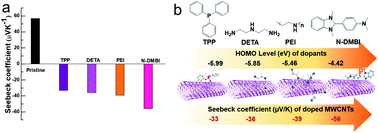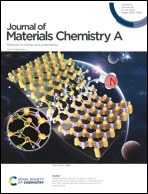Double doping approach for unusually stable and large n-type thermoelectric voltage from p-type multi-walled carbon nanotube mats†
Abstract
Multi-walled carbon nanotubes (MWCNTs) have shown low n-type Seebeck coefficients (−10 μV K−1), which are not good enough to prepare high performance low-cost MWCNT based mechanically flexible thermoelectric devices. Here, we present a double doping approach utilizing a small n-type doping molecule, 1,3-dimethyl-2-phenyl-2,3-dihydro-1H-benzimidazole (N-DMBI), in addition to encapsulated metal (iron) nanoparticles for achieving a high n-type thermoelectric performance with MWCNTs. With double doping, we have shown high n-type Seebeck coefficients up to −56 μV K−1 along with a power factor up to 112 μW m−1 K−2 at room temperature, which, to the best of our knowledge, is at least an order of magnitude higher than the power factors of previously reported n-type MWCNT based organic materials. More importantly, the negative Seebeck coefficient was maintained even after 60 days' exposure to air. An outstanding output power of 1.9 W m−2 at a temperature difference of 60 K was generated with a flexible thermoelectric device made of only MWCNT mats. The new findings could lead to the development of robust and flexible thermoelectric devices made of only low-cost MWCNTs.



 Please wait while we load your content...
Please wait while we load your content...